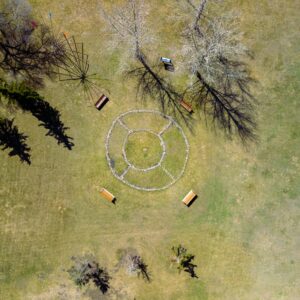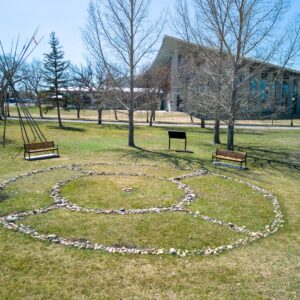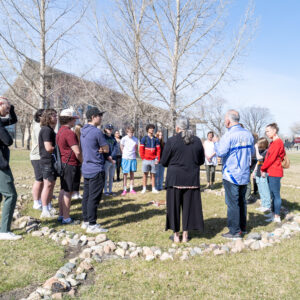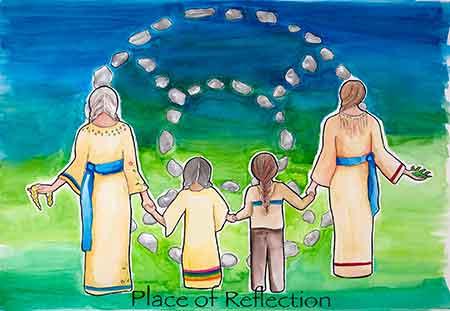“When someone dies, there is often a gravesite, a place to gather and remember; when someone vanishes, there is a void.”
(Lori Whiteman)
The Place of Reflection began with a concept and grew into the existing place of hope. It was inspired from a story…. In 2007, Lyndon Tootoosis carved a beautiful stone sculpture of a Kohkum featuring a medicine wheel. He called his creation, “I’ll Wait Here”, after an oral story passed down through generations of Plains Cree. Lori Whiteman heard Lyndon’s story, and was immediately moved. The story and the sculpture created a deep connection to her own story of her mother, Delores “Lolly” Whiteman, who is among Canada’s missing Indigenous women.
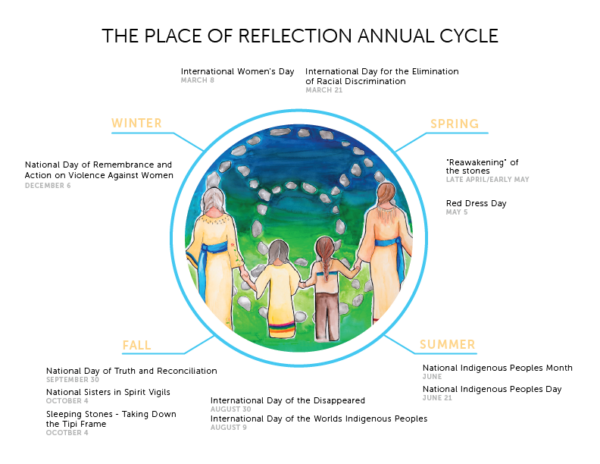
During the same time-period, a group of families had formed together to support, share, and search for answers about their missing and murdered Indigenous loved ones. It was recognized that there was an urgent need for support and a place to reflect and find peace. This was the beginning of the Place of Reflection. A committee was formed and the RCMP offered land on RCMP “Depot” grounds, adjacent to the RCMP Heritage Centre as a site for the creation of the Place of Reflection.
Lyndon Tootoosis began consulting with Elders and attended ceremonies to determine the type of sculpture to be placed. The original concept included a large stone sculpture, but after an injury, Lyndon suggested the placement of a medicine wheel, where rocks would be laid to symbolize the Missing and Murdered Indigenous Woman and Girls. The Place of Reflection was designed after additional consultation with Elders and based on ancient stone circle, or Medicine Wheels. The Place of Reflection stone circle consists of 1400 stones, which represented the number of missing people in Canada at the time the wheel was created. Since then, more stones have been placed including small stones gathered in June, 2021 after the discovery of unmarked graves at site of the former Kamloops Indian Residential School. In the centre of the wheel is a rock which is in the shape of a buffalo heart and it is the heartbeat of the wheel. The sacred stones came from an ancient campsite near the Qu’Appelle Valley, where they had been safely kept by a family for generations. According to Lyndon, the chance encounter with the farmer was a destiny.
The original idea for the Place of Reflection was born from the issue of murdered and missing Indigenous women and girls, but as the project grew and developed, it became clear that this was a place of potential reconciliation and hope for anyone who has experienced loss and grieving and would benefit from a place where they can draw strength and healing from the stone circle. The circle honours people from all directions. As a living sculpture, visitors may bring stones that represent their lost loved one. The circle is open to anyone, from any culture, religion, gender, or background. Ceremonies and offerings have been held for the Place of Reflection since 2009, and continue to be held each year. This is a special and sacred place.
We acknowledge that the land on which we gather, and where the RCMP Heritage Centre is located is Treaty 4 territory, which is the traditional territory of the Anihšinābēk, Nêhiyawak, Dakota, Lakota, and Nakota Peoples, and the original home of the Métis Nation. We recognize and acknowledge their culture and contributions.

